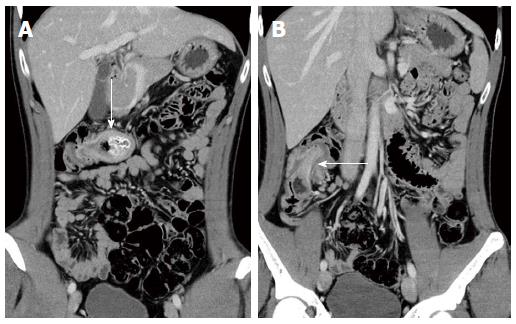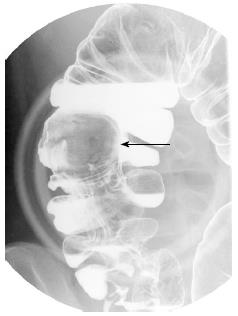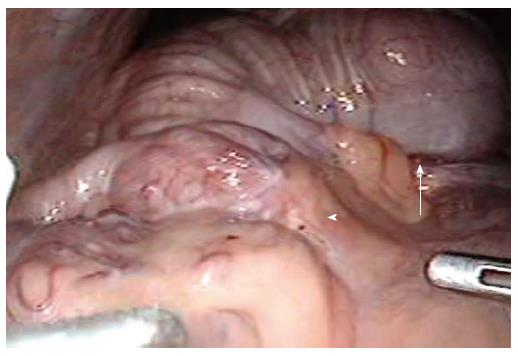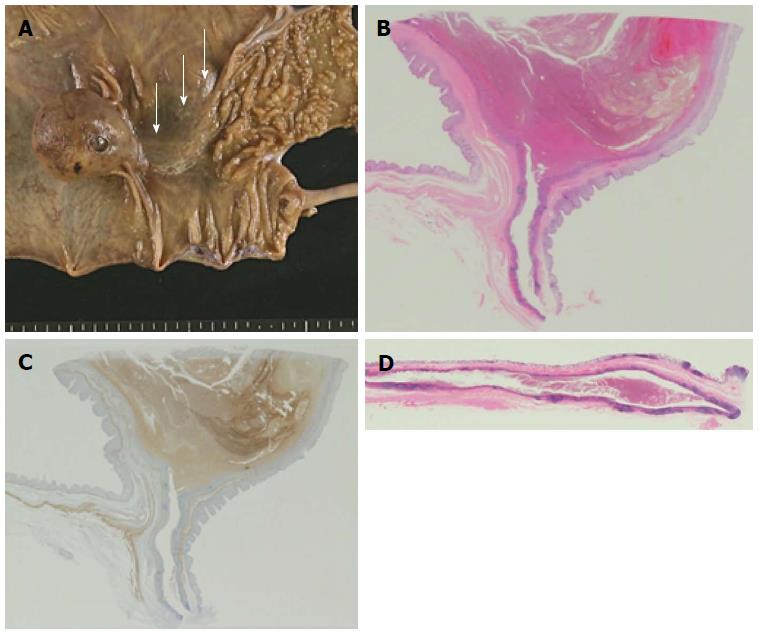Copyright
©The Author(s) 2016.
World J Gastroenterol. Feb 21, 2016; 22(7): 2398-2402
Published online Feb 21, 2016. doi: 10.3748/wjg.v22.i7.2398
Published online Feb 21, 2016. doi: 10.3748/wjg.v22.i7.2398
Figure 1 Coronal computed tomography of the abdomen.
A: A cystic lesion 4 cm in diameter in the transverse colon (arrow). The lesion contained stool-like material and acted as a lead point for intussusception; B: Intussusception of the right colon (arrow).
Figure 2 Barium enema.
A large submucosal mass (arrow) in the ascending colon originating near the ileocecal valve.
Figure 3 Colonoscopy.
A large submucosal mass in the ascending colon. Arrows indicate mucosal defects on the surface of the mass.
Figure 4 Intraoperative laparoscopic view.
A round mass in the hepatic flexure of the colon (arrow) causing an invagination of the ileocecal region into the ascending colon (arrowhead).
Figure 5 Pathological analysis.
A: A macroscopic view of the resected specimen. A round mass 4 cm in diameter is observed in the ascending colon. A submucosal tubular bulge measuring 5 cm in length extends from the round mass to the ileocecal valve (arrows); B and C: Magnified sectional views of the cystic lesion (loupe images; B: hematoxylin and eosin; C: desmin). The cystic lesion is lined by normal colonic mucosa and possesses its own muscular layer; D: A magnified sectional view of the tubular bulge (loupe image; hematoxylin and eosin). A blind-end tubular structure extends from the cystic lesion toward the proximal side to the ileocecal valve. This structure is lined by normal colonic mucosa and shares the muscular layer with the native ascending colon.
- Citation: Kyo K, Azuma M, Okamoto K, Nishiyama M, Shimamura T, Maema A, Shirakawa M, Nakamura T, Koda K, Yokoyama H. Laparoscopic resection of adult colon duplication causing intussusception. World J Gastroenterol 2016; 22(7): 2398-2402
- URL: https://www.wjgnet.com/1007-9327/full/v22/i7/2398.htm
- DOI: https://dx.doi.org/10.3748/wjg.v22.i7.2398













